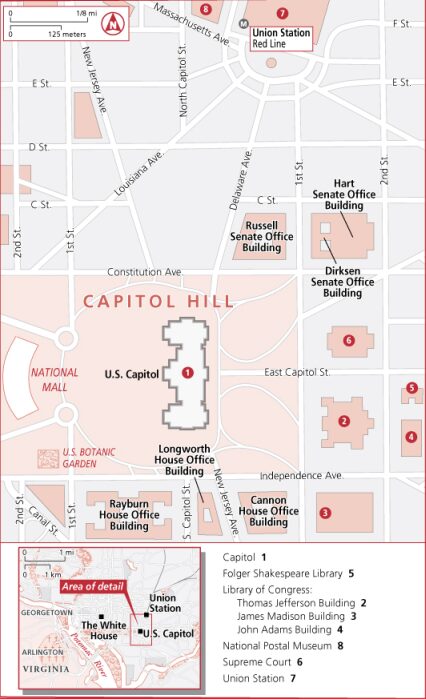United States Capitol Building
The United States Capitol Building, in Washington, D.C., is where the United States Congress meets.
Design
L'Enfant's proposed and partially executed plan (1791) for the layout of the entire city combined a gridiron design with coordinates varying in frequency and a system of radiocentric avenues derived from the two main foci of the President's House (White House) and the Capitol. His scheme derived from his concept of a strong nationally elected executive balancing a locally elected house of legislators. His emphasis on broad vistas was better suited for the capital of an empire rather than for a republic, while his awareness of scenic backdrops for his projected public buildings indicated the influence of the English cult of the picturesque.
A competition for the best design was held in 1792-93. French architect Etienne (or Stephen) Sulpice Hallet (1755-1825) refined designs by William Thornton, a physician and amateur architect, adapting baroque and neoclassical traditions to American themes. Hallet's four designs employed domes, statues, and other architectural details to invoke Roman civic ideals. Difficulties in planning the capitol building were not only structural, but also tied to the uncertainty of the operation and function of the federal government and its branches. Many of Hallet's design ideas from the early 1790s were incorporated into the final capitol design.
The Capitol was built from the original plans of William Thornton and Hallet; after the British burned it in 1814 it was rebuilt in 1815 under Benjamin Henry LaTrobe; there were later modifications by Charles Bulfinch and Thomas Ustick Walter.
Dome and art

Thomas Crawford's 19.5-foot 'Statue of Freedom,' stood on the Capitol dome from December 1863 to May 1993, when it was briefly removed for restoration and repairs. The statue has also been known as the Goddess of Freedom, the Goddess of Liberty, and the Indian Goddess.
Emanuel Leutze, a German-born artist, was commissioned by the U.S. Government to paint a mural on the western wall of the Capitol. Leutze, well known for his "Washington Crossing the Delaware"" and some 60 other historic paintings, painted the mural entitled "Westward the Course of Empire Takes Its Way." He wanted to present the grand peaceful conquest of the great west and in doing so he reflected his love of adventure, hero worship, and fondness of wild lethal fun

Security
Security has become a major issue since the Sept. 11, 2001, where the fourth plane may have been headed to the White House or the Capitol. The serenity and repose formerly offered by Frederick Law Olmsted's original capitol grounds landscape have been replaced with concrete barriers and machine-gun-wielding police who greet visitors and passersby with suspicion, in stark contrast to the air of friendliness and openness that used to prevail.
The landscaping around the Capitol grounds, designed by Frederick Law Olmsted, was partly sacrificed during 1999-2003 to construct the new Capitol Visitor Center and security points.
See also
Further reading
- Allen, William C. History of the United States Capitol: A Chronicle of Design, Construction, and Politics (Washington: Government Printing Office, 2001). 461 pp.
- Carrier, Thomas J. The White House, the Capitol, and the Supreme Court: Historic Self-Guided Tours (Chicago: Arcadia, 2000). 128 pp. online review
- Kennon, Donald R., ed. A Republic for the Ages: The United States Capitol and the Political Culture of the Early Republic (1999). 583 pp.
- Maroon, Suzy. The United States Capitol (1993), photographic history

